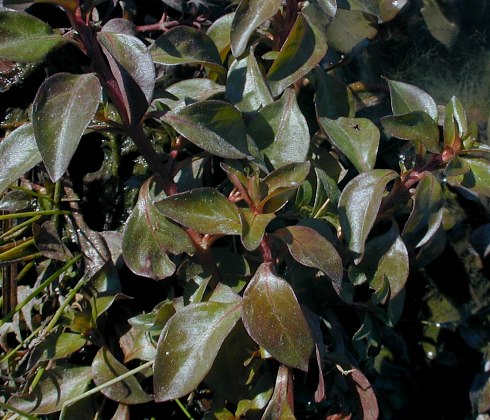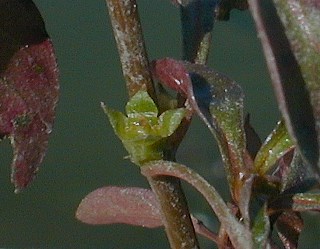Description: This is a herbaceous perennial plant about 3-12" long that branches occasionally. When it is out of the water, its stems and leaves sprawl across the ground; within shallow water, it ascends toward the surface, where its upper stems and leaves usually poke above the water. The stems are light green to bright red, glabrous, and somewhat succulent. The opposite leaves are up to 1½" long and ¾" across; they are lanceolate to ovate, medium green to dark reddish green, glabrous, and smooth along the margins. Each leaf tapers into a short petiole and has a blunt tip.

When the stems are above the water surface, sessile flowers develop from the axils of the middle to upper leaves; there is only one flower per leaf axil. Each flower has a short tubular calyx with 4 teeth, 4 short stamens, and a very short style above the developing ovary. The petals are absent or very small and insignificant. The calyx is green and glabrous, while its teeth are triangular-ovate. The blooming period occurs from mid-summer into the fall. The non-showy flowers are probably self-fertile. The seed capsule develops within the persistent calyx; it is a little less than ¼" long, 4-angled and flat-topped. Each 4-chambered seed capsule contains many tiny seeds. The root system is shallow and fibrous. This plant can reproduce vegetatively by forming rootlets near the axils of the lower leaves.
Cultivation:
The
preference is full sun to light shade and wet conditions. This plant
requires either wet muddy ground or clear shallow water (only a few
inches deep). The foliage becomes more red when it is exposed to
sunlight. Most growth and development occurs during the summer and
early fall.

Range & Habitat:
Marsh Purslane is fairly common throughout Illinois (see Distribution
Map). It is native to both North America and Eurasia.
Habitats include swamps, seeps, springs, muddy borders of
ponds, river
sandbars, and ditches. This plant thrives in wetlands with a history of
disturbance (whether human-caused or natural). It is probably becoming
more common because of the large number of ponds that have been created
along highways or near construction sites in cities.
Faunal Associations:
A bluish black flea beetle, Altica litigata, feeds
on the foliage of Marsh Purslane and other Ludwigia spp.
Among vertebrate animals, muskrats eat the foliage of Marsh Purslane.
The tiny seeds of this species can probably cling to the feathers or
muddy feet of ducks and geese; these waterfowl probably spread the
seeds to new wetlands.
Photographic Location:
Along the border of a pond in Champaign, Illinois.
Comments:
Marsh Purslane is not really noticeable until later in the summer. By
this time, it has become a small plant that is actively blooming and
forming seedpods, although this is not obvious to the casual observer.
It appears to be abandoning insect pollination as a species because its
flowers are not very showy. There are other Ludwigia spp.
with insignificant flowers that flourish in wetland habitats, but they
are taller plants with more narrow leaves. Some wetland plants in the
Loosestrife family (e.g., Ammannia coccinea
& Rotala ramosior) also have sessile seed
capsules in the axils of their leaves, but they have unbranched stems,
linear leaves, and small flowers with conspicuous petals.